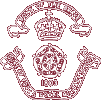| Navigation links at the bottom of this page |
|
| Post-war changes galore in uniforms |
|
FMS (false memory syndrome) is not confined to holders of high public office called to account before commissions of inquiry for their dubious performance of service. It can with equal severity afflict those with impeccable records and unquestionably honourable intentions. Recent correspondence suggests that memories of the uniforms and head dress worn during the post-war years, when traumatic changes in school life and the curriculum occurred, can sometimes be faulty. With the help of three ex-Dukies of that period, this account of uniforms and head dress worn in the 1950s should help refresh memories. |
|
Michael Ridlington (Wy 1951-1961) writes, 'When I was a newchie in 1951, we were issued with two khaki service dress tunics and shorts, one pair of blue serge shorts, white or green aertex underpants, brown stockings, khaki shirts, vests, a tie, nightshirts or pyjamas (I had one of each, nightshirts being phased out after a year or so), boots, gym shoes, khaki beret, a sweater ('jersey pullover'), single-breasted greatcoat, groundsheet (the same as that issued to soldiers, but not very waterproof), knitted gloves, handkerchiefs, PT vest, footer shorts, socks/shirt of colour according to house (dormitory in Haig), School brass cap badge and father's regiment cap badge. The tie, a khaki braid affair, was for use with battledress, not service dress. We tied Windsor knots in the khaki tie. Prefects wore the same braided, khaki tie. The civilian tie was of maroon, white and blue stripes, like the current OBA tie. Initially, the 'School tie' with roses was worn by members of staff, and adopted by the OBA. [Editor: The khaki beret is disputed by others who assert that blue berets were worn from the outset.]
|
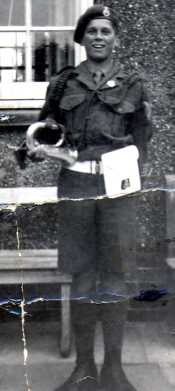 |
|
Our boots were ammo boots with caps that needed boning to bring them to a high polish finish. To bone them, we used a toothbrush handle with Kiwi, Cherry Blossom or Day and Martin's boot polish, known as 'School blacking' (shades of Charles Dickens!) and lots of spit and polish. Sometimes, we'd burn the old polish off by covering the boot liberally with blacking and setting it alight, after which the whole bulling process had to start again. |
|
Our service dress was the WWI uniform, simplified of course, but the same pattern worn by the RSM, CSMs and other uniformed noncoms. The commandant, headmaster, adjutant (now bursar), chaplain, doctor and RAEC officers all wore battledress during the week and service dress with the Sam Brown belt for Sunday church parade. Blues later replaced the traditional officers service dress. |
|
Frank Hartry (1946-1951) in 1949 in battledress jacket, collar and tie, wearing a khaki beret |
|
|
|
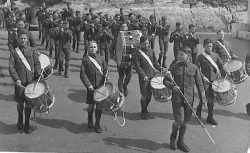 |
Regarding footer shorts, these were canvass linen affairs, nominally blue, which quickly faded to a pale grey, secured with a drawstring and having a concealed pocket inside the wasteband. [I kept mine right through my schooldays and only recently binned them.] The soccer and hockey teams wore sjorts of maroon and navy blue halves. The rugger team wore a single colour maroon shirt, stockings and rather classy blue woollen shorts. |
|
Regarding footer shorts, these were canvass linen affairs, nominally blue, but quickly faded to a pale grey, secured with a drawstring and having a concealed pocket inside the wasteband. [I kept mine right through my schooldays and only recently binned them.] |
|
Before 1950, the drum corps in 'service dress' jackets pattened on WWI uniform with breast pockets, but minus side pockets. |
|
|
|
|
 |
|
|
|
|
|
|
Most boys in senior houses had battledress for their best kit and service dress for everyday wear. The battledress gradually replaced the service dress, but we tinies had two service dresses, replaced by the battledress just in time for our first Grand Day. The last boy in the School to wear service dress was Geoffrey Stopford of Marlborough. The service dress was of a special design, with two breast and no side pockets, and only one hook to fasten the collar.
|
 |
Two types of brass buttons appear here: the larger buttons were on both the single and double-breasted khaki greatcoat. The small buttons were on the front edge of the khaki side hat, which also had two lines of red piping running for' an aft. |
|
|
 |
|
|
|
We wore no headdress during the week but khaki berets for Spra's Saturday parade and to watch games on Saturday afternoon, for which some senior boys still had khaki side caps, some with GVR cap badges. Blue berets came in during my first year and were worn on church parade. Khaki berets were soon phased out. Prefects wore berets at all times, right through my ten years. School prefects came in three flavours: a house prefect had three stripes, a junior school prefect wores a five-pointed and senior house prefects a seven-pointed star above their sergeant's stripes. All prefects wore two brass York stars on their tunic collars or lapels on battledress. The Chief School Prefect wore a brass crown above his stripes. Blue serge shorts were worn only when one's khaki shorts were at the tailor's shop. No 1 Dress, 'blues', came in during my second year in Wolseley. This included a red belt, black and gold epaulettes for the Band and Drums, and peaked caps for the prefects. |
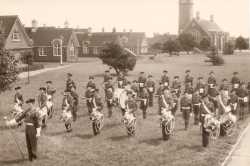 |
Compare the Drum Corps in 1955 with the preceding image pre-1949. Here the uniform is battledress top, epaulettes and blue berets, which replaced the khaki beret |
| |
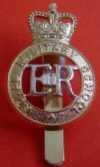 |
Long trousers were issued when you reached 5 ft 2 in and toe capless shoes when your feet were size 4. You had one pair of 'best' boots and one of 'old' boots. Boys in the 'M' stream also had a pair of gardening boots. Greatcoats were mandatory in winter until morning break, then again from teatime. Similarly with shirtsleeve order in summer. Double-breasted greatcoats gradually replaced the single breasted variety. They came with khaki bakelite buttons and you had to sew on no less than 15 brass buttons! Much later, after the Coronation of HM Queen Elizabeth, GVIR brass buttons and cap badges were replaced by anodised aluminium EIIR, of which I still have examples. GVIR of course was the cipher for King George the Sixth. It was incorporated, in silver metal, in the centre of the School cap badge. |
|
 |
 |
|
|
|
|
|
|
Civilian clothes (blue blazer with badge, grey shorts, grey or white shirt, School tie and cap with badge) were not free issue. The blazers were supplied by Lock Outfitters of Dover at a cost of about thirty shillings. Some parents, especially widowed mothers, were hard-pressed to find the money, for the 1950s were not the affluent years they are today. Civvies were worn on Wednesday, Saturday and Sunday afternoons unless you were under punishment. Prefects were allowed to wear lounge suits.
On discipline, I don't believe, with the possible exception of Fritz, that caning was excessive. Housemasters were obliged to enter their canings into a punishment book. School swishes, administered by Spra, were for the most serious offences not meriting expulsion, were mercifully rare, were published in School Daily Orders for all to see, and were invariably accompanied by forfeiture of a 'dodger' (good conduct badge). Lower level corporal punishment was usually by means of a gym shoe (Wolseley Head of House Whiting was quite good at this!) and died out fairly early in my time. Fritz only caned me once, as he left
at the end of my first term in Wolseley. Other punishments were fatigues on a Saturday afternoon and 'full kits' where you had to display all your possessions neatly laid out for inspection before bedtime. Most juniors in Wolseley were on permanent full kits under boy Corporal Philip Booth, who later a CSM in the Worcestershire Regt. Fatigues were awarded by prefects and NCOs, who wrote them into a notebook and transcribed them into the fatigue book over Saturday lunchtime. Sometimes prefects forgot to do this but one of them, Alan Coombes, was meticulous in recording them. Three or more fatigues awarded in a week usually meant a caning from Fritz or Funge (see Dictionary of staff bios). I'm proud that I never awarded a single fatigue during my time as a prefect.
|
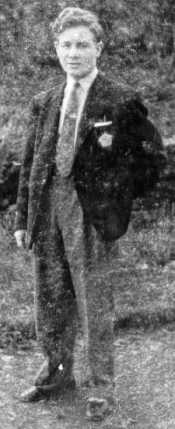 |
Leonard Goble (1949-54) in civvy blazer introduced post-war. |
Under the Nye reforms the senior School was divided into G (grammar), T (technical) and M (modern) streams. In September 1955, the streams were changed to A, B and C for Forms 1 to 3. Forms 4 and 5 stayed the same but with the addition of an S (Sandhurst) stream that replaced the M stream.
One last note. CSMs were phased out or relegated rather to less important duties when the RAEC and civilian officer-type housemasters were installed soon after the school returned to its Dover quarters.
Note: This acknowledges the considerable help from three ex-Dukies of the 1950s era: Gus Bainger, Michael Ridlington and Frank Hartry.
|
|
|
 |
|
|
|
|
|
|
 |
|
|

